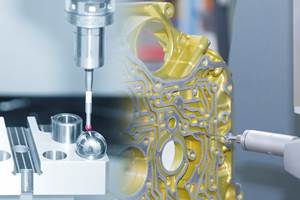Working With Your Working Gage Blocks
The uses of working gage blocks are as varied as the number of gage blocks in a large set. The working blocks have an intermediate grade and are often used in the inspection or calibration lab, but they may also be found on the shop floor.
Share





The uses of working gage blocks are as varied as the number of gage blocks in a large set. The working blocks have an intermediate grade and are often used in the inspection or calibration lab, but they may also be found on the shop floor. We are not talking about the master gage block set that is used as the corporate standard or the shop floor set that levels an old table. As part tolerances become tighter and the resolution of comparative gaging becomes higher, the use of working gage block sets for toolmaking and part inspection is widespread.
Of course, the most common use of the gage block is to provide a reference for direct measurement of distances between parallel surfaces, such as widths of grooves. The blocks can be used as a go/no go gage or as a means of setting up a comparative measurement. The ability to stack the gage block set to any length makes the gage invaluable as a tool in the inspection lab.
Another important use of the working block is for checking the performance of hand tools and gaging equipment. Micrometers and other hand measuring instruments can be checked for linearity (degradation of the micrometer thread). Using gage blocks of different sizes that are stepped, usually in equal increments over the measuring range of the measuring tool, provides a means for checking the performance of the tool. The gage blocks are also useful for setting a reference point on measuring tools where the measuring capacity of the gage is larger than the measuring range of the gage itself. For example, a 3-inch gage block would be used to set the 3-inch reference point on a 3 to 4-inch micrometer. With these measuring tools, the spindle does not touch the fixed contact, so a gage block provides a precision method of setting a starting point.
Limit gage sets can be created with two sets of gage blocks or gage block stacks set to the high and low tolerance limits. These sets would consist of gage block stacks with added contact elements or end jaws combined to the limits specified. They provide an easy-to-assemble and reliable means of producing temporary gaging for an unexpected application. In the long run, however, it is more economical to have a fixed gage made for these applications, as assembly and disassembly is time consuming and subject to stacking error.
In inspection, a frequent use of these blocks is to set up for comparison or transfer measurements during surface plate work. Using a single block or stack for a height reference is the common approach. By adding another gage block or end jaw that overhangs the block, an inside dimension can be established. A base, holding rods and end jaws are often found in a gage block accessory kit. They allow the assembly area to perform medium accuracy comparisons with surface plate work. Finally, the use of gage blocks and a sine plate on the surface plate create a very precise angle setup. The double requirement of accurate length and perpendicularity to the base is a perfect use of the working gage block. Using fairly straightforward trig, the right angle reference set up by the blocks and the known length of the sine plate make for easy angle setup.
Gage blocks need preparation before they can work. The process includes making sure that they are recently certified, checked for nicks and burrs and stabilized for the temperature of the work area.
With care and careful handling, working gage blocks can contribute significantly to a manufacturer's productivity.
Related Content
The Link Between CNC Process Control and Powertrain Warranties
Ever since inventing the touch-trigger probe in 1972, Sir David McMurtry and his company Renishaw have been focused on achieving process control over its own manufacturing operations. That journey has had sweeping consequences for manufacturing at large.
Read More4 Ways to Establish Machine Accuracy
Understanding all the things that contribute to a machine’s full potential accuracy will inform what to prioritize when fine-tuning the machine.
Read MoreProcess Control — Leveraging Machine Shop Connectivity in Real Time
Renishaw Central, the company’s new end-to-end process control software, offers a new methodology for producing families of parts through actionable data.
Read MoreRethink Quality Control to Increase Productivity, Decrease Scrap
Verifying parts is essential to documenting quality, and there are a few best practices that can make the quality control process more efficient.
Read MoreRead Next
Machine Shop MBA
Making Chips and Modern Machine Shop are teaming up for a new podcast series called Machine Shop MBA—designed to help manufacturers measure their success against the industry’s best. Through the lens of the Top Shops benchmarking program, the series explores the KPIs that set high-performing shops apart, from machine utilization and first-pass yield to employee engagement and revenue per employee.
Read MoreAMRs Are Moving Into Manufacturing: 4 Considerations for Implementation
AMRs can provide a flexible, easy-to-use automation platform so long as manufacturers choose a suitable task and prepare their facilities.
Read More



















